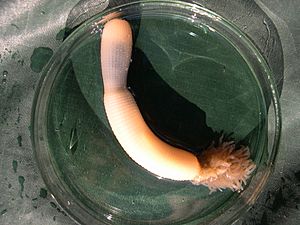Cycloneuralia facts for kids
Quick facts for kids Cycloneuralia |
|
|---|---|
 |
|
| Priapulus caudatus, a type of priapulid worm. | |
| Scientific classification |
|
| Kingdom: | Animalia |
| Superphylum: | Ecdysozoa |
| Clade: | Cycloneuralia |
| Groups | |
|
|
Have you ever heard of an animal with its brain wrapped around its throat? Meet the Cycloneuralia, a supergroup of worm-like animals with this very strange feature. Their scientific name comes from Greek words meaning "circle" (cyclo) and "nerve" (neuron), which perfectly describes their unique nervous system.
These animals are part of an even bigger group called Ecdysozoa. This group includes all animals that must shed their outer layer, or exoskeleton, to grow. This process is called molting. So, just like a cicada or a snake sheds its skin, so do the Cycloneuralia.
What Makes an Animal a Cycloneuralian?
The main feature that connects all these different creatures is the shape and position of their brain. Instead of having a single brain located in a "head," their brain forms a ring around their pharynx (the tube that connects the mouth to the digestive system). It's like wearing the brain as a collar!
Scientists believe this group first appeared during the Cambrian Period, over 500 million years ago. Today, they are found in almost every environment on Earth, from the deep sea to the soil in your backyard.
Family Tree Mysteries
Scientists are still working to understand the exact relationship between Cycloneuralia and other animal groups. For a long time, they were grouped together in a phylum called Aschelminth, or Nemathelminthes.
Today, most scientists think they are close relatives of the Panarthropoda, a group that includes insects, spiders, crabs, and velvet worms. You can think of them as distant cousins on the animal family tree. The exact branching of this tree is still a topic of research and debate among biologists.
Types of Cycloneuralia
The Cycloneuralia group is very diverse. It includes several major types of animals, some of which are very common, while others are microscopic and rare.
Nematoida: The Thread-Like Worms
This group includes some of the most well-known worms.
Nematodes (Roundworms)
Nematodes, or roundworms, are incredibly common. It's been said that if you removed everything on Earth except for the nematodes, you would still see a faint outline of the world. They live in soil, fresh water, salt water, and even inside other plants and animals as parasites. Most are tiny, but some can grow to be several meters long.
Nematomorpha (Horsehair Worms)
Nematomorphs are famous for their long, thread-like bodies, which is why they are called "horsehair worms." As larvae, they live as parasites inside insects like crickets and grasshoppers. When they become adults, they leave their host to live and reproduce in water.
Scalidophora: The Spiny-Headed Worms
The name Scalidophora means "scale-bearer." These animals all have spines on their head, which they can often retract into their body.
Priapulida
Priapulids are marine worms that live buried in the mud on the ocean floor. They get their common name from their body shape. They have a spiny, extendable snout called a proboscis, which they use to catch small prey. The species Priapulus caudatus is a classic example.
Kinorhyncha (Mud Dragons)
With a cool nickname like "mud dragons," you might expect something large, but kinorhynchs are microscopic. These tiny creatures live in marine mud and sand. They move by pulling themselves along with the spines on their head.
Loricifera (Girdle-Bearers)
Loriciferans are some of the smallest known animals on Earth. Their name means "girdle-wearer," and it refers to their protective outer casing, called a lorica, which looks like a tiny suit of armor. Amazingly, some species can live in environments with no oxygen at all.
Palaeoscolecida: The Ancient Worms
This group of worms is entirely extinct. We only know about the Palaeoscolecida from fossils that are hundreds of millions of years old. These fossils are very important because they show what the ancient ancestors of Cycloneuralia looked like. They had bodies covered in small, mineralized plates, which helped them become preserved as fossils.
See also
 In Spanish: Cycloneuralia para niños
In Spanish: Cycloneuralia para niños

